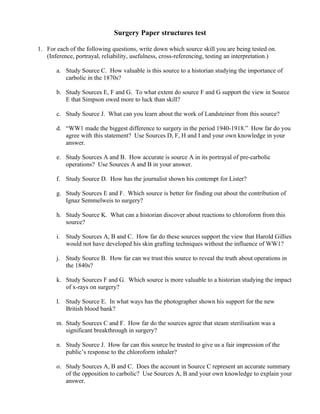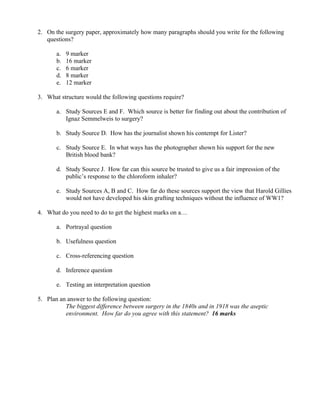Surgery paper structures test
- 1. Surgery Paper structures test 1. For each of the following questions, write down which source skill you are being tested on. (Inference, portrayal, reliability, usefulness, cross-referencing, testing an interpretation.) a. Study Source C. How valuable is this source to a historian studying the importance of carbolic in the 1870s? b. Study Sources E, F and G. To what extent do source F and G support the view in Source E that Simpson owed more to luck than skill? c. Study Source J. What can you learn about the work of Landsteiner from this source? d. ŌĆ£WW1 made the biggest difference to surgery in the period 1940-1918.ŌĆØ How far do you agree with this statement? Use Sources D, F, H and I and your own knowledge in your answer. e. Study Sources A and B. How accurate is source A in its portrayal of pre-carbolic operations? Use Sources A and B in your answer. f. Study Source D. How has the journalist shown his contempt for Lister? g. Study Sources E and F. Which source is better for finding out about the contribution of Ignaz Semmelweis to surgery? h. Study Source K. What can a historian discover about reactions to chloroform from this source? i. Study Sources A, B and C. How far do these sources support the view that Harold Gillies would not have developed his skin grafting techniques without the influence of WW1? j. Study Source B. How far can we trust this source to reveal the truth about operations in the 1840s? k. Study Sources F and G. Which source is more valuable to a historian studying the impact of x-rays on surgery? l. Study Source E. In what ways has the photographer shown his support for the new British blood bank? m. Study Sources C and F. How far do the sources agree that steam sterilisation was a significant breakthrough in surgery? n. Study Source J. How far can this source be trusted to give us a fair impression of the publicŌĆÖs response to the chloroform inhaler? o. Study Sources A, B and C. Does the account in Source C represent an accurate summary of the opposition to carbolic? Use Sources A, B and your own knowledge to explain your answer.
- 2. 2. On the surgery paper, approximately how many paragraphs should you write for the following questions? a. 9 marker b. 16 marker c. 6 marker d. 8 marker e. 12 marker 3. What structure would the following questions require? a. Study Sources E and F. Which source is better for finding out about the contribution of Ignaz Semmelweis to surgery? b. Study Source D. How has the journalist shown his contempt for Lister? c. Study Source E. In what ways has the photographer shown his support for the new British blood bank? d. Study Source J. How far can this source be trusted to give us a fair impression of the publicŌĆÖs response to the chloroform inhaler? e. Study Sources A, B and C. How far do these sources support the view that Harold Gillies would not have developed his skin grafting techniques without the influence of WW1? 4. What do you need to do to get the highest marks on aŌĆ” a. Portrayal question b. Usefulness question c. Cross-referencing question d. Inference question e. Testing an interpretation question 5. Plan an answer to the following question: The biggest difference between surgery in the 1840s and in 1918 was the aseptic environment. How far do you agree with this statement? 16 marks

